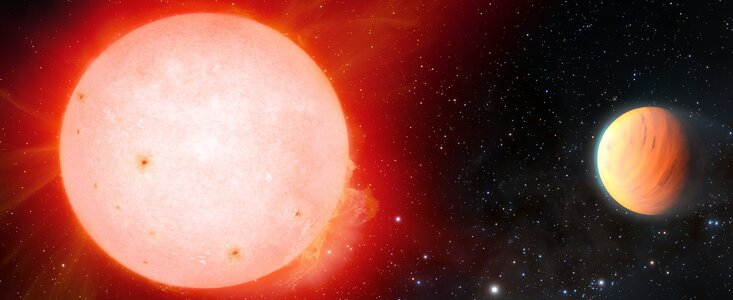'Marshmallow' World Orbiting a Cool Red Dwarf Star [View all]
 A gas giant exoplanet with the density of a marshmallow has been detected in orbit around a cool red dwarf star by a suite of instruments, including the NASA-funded NEID radial-velocity instrument on the WIYN 3.5-meter Telescope at Kitt Peak National Observatory, a Program of NSF’s NOIRLab. The planet, named TOI-3757 b, is the fluffiest gas giant planet ever discovered around this type of star.
A gas giant exoplanet with the density of a marshmallow has been detected in orbit around a cool red dwarf star by a suite of instruments, including the NASA-funded NEID radial-velocity instrument on the WIYN 3.5-meter Telescope at Kitt Peak National Observatory, a Program of NSF’s NOIRLab. The planet, named TOI-3757 b, is the fluffiest gas giant planet ever discovered around this type of star.Astronomers using the WIYN 3.5-meter Telescope at Kitt Peak National Observatory in Arizona, a Program of NSF’s NOIRLab, have observed an unusual Jupiter-like planet in orbit around a cool red dwarf star. Located approximately 580 light-years from Earth in the constellation of Auriga the Charioteer, this planet, identified as TOI-3757 b, is the lowest-density planet ever detected around a red dwarf star and is estimated to have an average density akin to that of a marshmallow.
Red dwarf stars are the smallest and dimmest members of so-called main-sequence stars — stars that convert hydrogen into helium in their cores at a steady rate. Though “cool” compared to stars like our Sun, red dwarf stars can be extremely active and erupt with powerful flares capable of stripping a planet of its atmosphere, making this star system a seemingly inhospitable location to form such a gossamer planet.
“Giant planets around red dwarf stars have traditionally been thought to be hard to form,” says Shubham Kanodia, a researcher at Carnegie Institution for Science’s Earth and Planets Laboratory and first author on a paper published in The Astronomical Journal. “So far this has only been looked at with small samples from Doppler surveys, which typically have found giant planets further away from these red dwarf stars. Until now we have not had a large enough sample of planets to find close-in gas planets in a robust manner."
There are still unexplained mysteries surrounding TOI-3757 b, the big one being how a gas-giant planet can form around a red dwarf star, and especially such a low-density planet. Kanodia’s team, however, thinks they might have a solution to that mystery.
https://noirlab.edu/public/news/noirlab2225/
